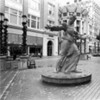Ben Hazard paces from one window to another in his office on the ninth floor of City Hall, hardly able to contain his excitement as he talks about the state of the arts in Oakland. The head of the city’s Craft and Cultural Arts Department is so energized he can’t even sit still for an interview; he ticks off the city’s great accomplishments in run-on phrases. This year, he says, saw the opening of the city-funded Oakland Art Gallery, the birth of the Third Thursday Oakland Art night (downtown galleries keep their doors open until 8:00 p.m.), the expansion of the Oakland Artisan Marketplace on Fridays in Frank Ogawa Plaza, the lighting of the Fox Theater sign. Gesturing with his hands as if stirring the very air around him, Hazard proclaims that Oakland is experiencing an arts renaissance.
Funny — that’s not what the art community thinks.
“I have a pretty grim view,” says playwright and poet Judith Offer. “Every time I go [anywhere else], I’m amazed at our lack of everything.”
“[Jerry Brown] can talk about the arts, but his heart is in the military. I think that’s antithetical to the arts,” says Pro Arts director Betty Kano. “The city has not really embraced the arts.”
“I think the state of the arts is not even on the city’s radar screen,” summarizes Sonia Ma?jon, associate director of the Center for Art and Public Life at the California College of Arts and Crafts. Mañjon should know — the former codirector of the city’s newly created art department quit in frustration last year after only six months on the job.
If a recent hour-long documentary about Jerry Brown’s efforts to revitalize Oakland is any indication, Mañjon’s assessment is right on the money. The Celebrity and the City, which aired in October, examined three of the mayor’s four platform issues. Noticeably absent was the fourth: supporting the arts.
None of this comes as a surprise to local artists, who have long complained that Brown talks up arts in Oakland while refusing to ante up the cost of its flourishing. And disappointment is always more severe when hope is dashed: When Brown came into office, he elevated city arts oversight from a division under Parks and Recreation to its own department. This telegraphed the right message, and arts and performance groups were thrilled that having their own department would eliminate the double-bookings and disorganization they’d experienced under Parks and Rec. But dysfunction of another variety set in almost immediately, and of course, the money wasn’t — and still isn’t — sufficient to begin to deal with the multiple problems Oakland artists face.
Meanwhile arts organizers are bracing for a slim 2002; private and corporate funding has decreased with the economic downturn, and the city’s grants only go so far. Mary Marx, director of children’s museum MOCHA, says individual donations have fallen significantly. “As soon as September 11 happened, we started doing a forecast because it was pretty clear that it will probably be more competitive to get grants,” she says. “The other concern I have is the impact on school districts. It’s difficult to know if they’re going to be able to support and improve [arts education] when they’re looking at significant shortfalls themselves.”
Still, bad times come and go; in Oakland, lack of affordable space has become a constant. Even though the rental market has come down a bit, it’s still very difficult to find available spaces that can be rented for either performances or studios.
And then there’s the ongoing Jacques Barzaghi soap opera. Barzaghi stepped down as codirector of the Craft and Cultural Arts Department in July after a city employee accused him of sexual harassment, but that was only the latest wrinkle — he’s been under fire ever since the department spun off from Parks and Rec. According to critics, Barzaghi turned much of his job over to others but retained the power to make decisions, which left the department unable to move ahead on key issues.
The city’s interactions with artists, in terms of awards and art commission dealings, have fared little better. Local artists protested when the city picked New York artist R.M. Fischer’s sculpture for the fountain in Frank Ogawa plaza; a new dispute arose when the city rescinded its offer to Fischer and picked Oakland sculptor Bruce Beasley’s piece Vitality instead. Beasley had been vocal in his opposition to Fischer’s piece, and other artists cried foul, alleging that the city didn’t cast a large enough net in its second search.
A group of artists called the Team of Five, who won a design proposal to install guardrails and a light sculpture for the I-880 underpass nearly two years ago, has seen their project called off, then on again. Former gallery owner and arts commissioner Beth Gates raised eyebrows when, after lobbying the City Council on the merits of a city-financed gallery, resigned her commission post to head it. Most recently, an outcry erupted over Scott Donahue’s sculpture Sigame which, while ostensibly honoring women, has offended some people because it’s a composite of twenty different women, with different body parts visibly bolted together.
Dan Fontes, who is becoming as well-known for his criticism of Oakland’s arts policies as for his murals, notes that the city should have followed its own process. “What all three [sculptures] should have had was public input. Why wasn’t it there? Sigame is a process issue — an issue of why women’s voices weren’t allowed to surface.”
It’s unclear whether Sigame even gained approval from the arts commission. And the commission itself, whose members are appointed by the mayor for four-year terms, has come under fire for being well-meaning, but ineffective.
The energetic Hazard puts a positive spin on these conflicts; he’s pleased that public art has spurred so much discussion. To him, the issue is not about process but aesthetics. Some people, he says, just don’t like the sculptures’ looks. “Process becomes a political tool that individuals who want to dispute it bring up,” he says. “Process should be a guide, especially for those who don’t know the field and how to make things happen.”
Hazard, this summer, considers himself a man who makes things happen. And he subscribes to Jerry Brown’s anti-bureaucracy, just-go-do-it attitude. To illustrate his point, Hazard places a mug in the middle of a table. The mug needs water, he says, and his job is to deliver, to get the water there no matter what. “I fill it with water and then go back and check and make sure we have the bases covered,” he explains.
More coherent is his story about attending an art convention in New York. To his amazement, he says, people didn’t want to talk about San Francisco arts; they wanted to discuss the scene in Oakland under Jerry Brown. “The image became so strong that no one talked about the crime, poverty, or ethnicity. The excitement of what’s happening in Oakland, what’s happening with the arts, is making people talk about the city.”
If artists don’t realize they’re living in a cultural renaissance, it’s because they don’t want to, Hazard says. (Nevertheless, he’s starting a billboard campaign in January to advertise some of the city’s artistic offerings.)
When it’s pointed out that a renaissance needs a room, Hazard says he has just the thing. The ArtPlaces program, which began in July, has produced a database of Oakland gallery spaces, live/work developments, studio spaces, and vacant warehouses. But judging by the way Oakland handles its own city-subsidized spaces, hopes don’t run high for success. The fate of visual arts program Studio One, which needs a $10 million retrofit, still lingers in uncertainty as fund-raising stalls, and relations between the city and Studio One’s community advisory group sour. Tensions have finally eased at the long-embattled Alice Arts Center after the city worked out a lease with the resident groups; most recently, artists were afraid they would be displaced by the mayor’s arts charter school.
And recently the Oakland Asian Cultural Center closed its doors after a lethal combination of internal infighting, community misunderstandings, financial problems, and lack of effective city oversight. The Oakland Museum has since stepped in to oversee day-to-day operations, in the same way it was earlier called in to help with the Alice Art Center.
Part of the problem is that the city wants a big bang for its arts buck: Headline-making festivals and large performance spaces. Pro Arts’ Kano says that efforts like the artisan marketplace are nice touches but that festivals and the like don’t help artists earn a living. What communities need, she says, especially minority communities, are small venues and galleries where art can be exhibited. “There’s a lot of art that doesn’t see the light of day,” Kano says. “There’s very little access to space.”
On a Friday evening at the Eastside Arts Alliance, a group of teenage boys sits quietly around a table, heads bent, attention drawn to the paper beneath their hands. The boys are taking a graffiti class where they learn to make murals and banners. But today, the instructor has forced them to try a little brush painting. Got to keep expanding those skills, he tells them.
Located in the San Antonio neighborhood, Eastside Arts Alliance serves as an umbrella group for four groups: Taller Sin Fronteras, Black Dot Artists, TDK, and C-4. The organization programs the Malcolm X Jazz Festival and also teams up with other agencies like the East Bay Asian Youth Center to provide after-school art classes.
When Letitia Ntofon of Black Dot talks about art, she prefaces her comments by clarifying that she speaks specifically about African-American art, not art for white folks. “For me, personally, it’s been in a slump. Stuff is popping off, but I feel there’s a lack of accountability.” Ntofon believes minority communities need minority-owned art spaces. Once, there was such a space, the Black Dot Cafe, but it closed when high rents forced its eviction.
Elena Serrano, director of Eastside, says owning space is not just about self-expression, but about preserving culture. “Having space keeps culture vibrant and relevant, and when you don’t have venues or theaters to work with or execute ideas, that’s leaving it wide open for anyone to move in.” Anyone means white artists (or “settlements” as Serrano calls them) whose move to the neighborhood signals that yuppies are not far behind. “They talk about community all the time, but I figured out what they’re really talking about — their own community,” she says.
For Serrano, real community is found in events like Tamalada (a night of free tamales and cultural performances), which took place a couple Thursdays ago. People come for the food and to see their children perform, and then they’re willing to stay afterwards to discuss issues like housing and schools. “I think art is seen as bringing in people, but [it’s not seen] how the arts can build community. What people know, what they eat, how they dance, is important. People feel respected when you acknowledge their culture. [Art ] allows dialogue between cultures.”
Acknowledging cultures is crucial in a neighborhood like the San Antonio district, which includes African-Americans, Latinos, and Asians. Serrano believes that’s why the neighborhood needs a cultural arts center — and why the city should help them get one. But Jerry Brown seems focused on bigger arts groups, she says. She has heard him talk about how money given to big arts organizations will trickle down to small grass-roots groups like hers. “If that’s his plan, by the time the money trickles down, we may not be here.”
Cultural centers should be like libraries, Serrano says. Every neighborhood should have one. As she talks, the graffiti arts instructor strolls into the room, looking for a folder. “Estria,” Serrano says, “what do you think of the art scene in Oakland?”
“What art scene?” he asks.
















